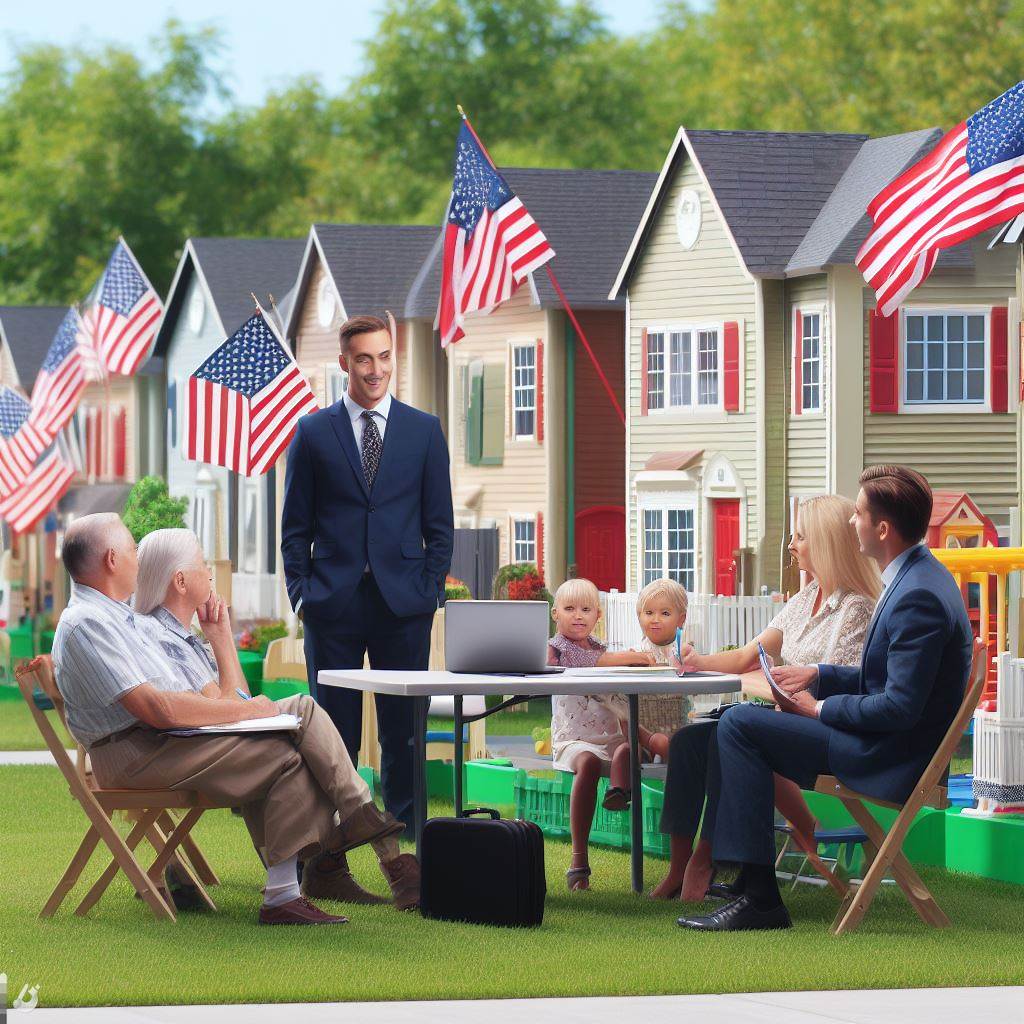Introduction
Homeowners’ Association (HOA)
HOA Rules Impact on Property Rights are overseen by a pivotal entity, as homeowners’ associations (HOAs) manage communal aspects such as amenities, landscaping, and maintenance, ensuring adherence to community standards.
Impact of HOA rules on property rights
This exploration centers on how HOA regulations, though essential for community cohesion, can intersect with individual property rights.
HOAs wield authority over architecture, landscaping, and external modifications, influencing the property’s aesthetic and potentially its value.
In the pursuit of community harmony, it’s paramount to comprehend the delicate equilibrium between collective governance and personal property rights.
Striking this balance necessitates understanding the implications of rules governing everything from paint colors to structural alterations.
Navigating the intricacies of HOA guidelines becomes crucial for homeowners aiming to preserve their property rights while contributing to a flourishing community.
This blog post will dissect these complexities, shedding light on the multifaceted relationship between HOA rules and property rights.
Stay tuned for insights into maintaining a harmonious coexistence within the framework of Homeowners’ Associations.
Understanding HOA Rules
The purpose of HOA rules in maintaining property standards
Homeowners’ Association (HOA) rules serve a vital role in upholding property standards within a community.
These rules aim to ensure that all homeowners contribute to the overall well-being and appearance of the neighborhood.
By establishing guidelines on the upkeep of yards, exterior maintenance, architectural designs, and other aspects, HOAs maintain the overall aesthetics of the community.
This helps maintain property values, as the neighborhood appears more attractive and desirable to potential buyers.
How HOA rules are established and enforced
HOA rules are typically established through a governing board, composed of elected homeowners who represent the community.
Initially, the board consults legal experts in drafting bylaws and rules that align with the community’s overall vision.
Once developed, these rules are shared with homeowners for review and feedback.
Following a consensus-building process, the rules are then amended if necessary to reflect the collective interests of the community.
Consensus is essential to ensure that the rules are fair and reasonable for all residents.
Enforcement of HOA rules is crucial to maintain harmony within the community.
A system of warnings and fines is commonly employed to encourage compliance.
Homeowners who repeatedly violate the rules may face legal action or restrictions on utilizing certain community amenities until compliance is achieved.
Importance of community consensus in creating and modifying rules
Community consensus plays a pivotal role in the creation and modification of HOA rules.
It ensures that the rules reflect the collective will of the residents and prevents the imposition of unpopular restrictions.
By involving all homeowners in the decision-making process, the HOA prevents any one individual or group from exerting undue influence.
This promotes a sense of ownership and collective responsibility within the community, fostering a stronger sense of belonging and cooperation.
Additionally, community consensus helps to address various concerns and considerations that might arise during the rule creation process.
Homeowners have the opportunity to voice their opinions, propose amendments, and suggest alternatives, ensuring that the final rules are comprehensive and acceptable to all.
Moreover, consensus-building fosters a stronger sense of community unity and understanding.
Through open dialogue, residents have the opportunity to understand the rationale behind certain rules, leading to better compliance and reduced conflicts.
Simply put, HOA rules are vital in upholding property standards and maintaining the overall appeal of a community.
The establishment and enforcement of these rules require the active participation and collective agreement of homeowners.
Consensus-building ensures fair and reasonable rules that promote unity, cooperation, and a sense of ownership within the community.
By abiding by these rules, homeowners contribute to the preservation of property rights and the overall well-being of their neighborhood.
Read: A Homeowner’s Guide to Property Easements
Types of HOA Rules
Homeowners’ Associations (HOAs) have become increasingly common in modern residential communities.
These associations enforce a set of rules and regulations designed to maintain community standards and protect property values.
The impact of HOA rules on property rights is a topic of interest for many homeowners and prospective buyers.
Exterior rules
One of the types of HOA rules is exterior rules.
These rules govern property aesthetics, landscaping, and renovations.
Homeowners are often required to maintain their homes in a certain manner and adhere to specific guidelines when making changes to their property.
The purpose of such rules is to ensure a uniform appearance throughout the community, which can enhance property values and attract buyers.
Behavioral rules
Behavioral rules are another type of HOA rule.
These regulations govern various aspects of homeowners’ behavior within the community.
They may include restrictions on noise levels to maintain peace and quiet, rules regarding pets to prevent nuisance and maintain cleanliness, and guidelines for parking to ensure proper utilization of limited space.
Behavioral rules are aimed at fostering a harmonious living environment and preventing conflicts between neighbors.
Amenities rules
Another category of HOA rules is amenities rules.
These guidelines outline the proper use of shared facilities within the community, such as gyms, pools, and parks.
They specify the operating hours, usage restrictions, and any additional rules related to the amenities.
These rules help ensure fair access to amenities and prevent misuse or overuse by certain individuals.
HOA rules can have a significant impact on property rights.
They might limit an individual homeowner’s freedom to personalize their property or restrict certain behaviors that are considered normal in other communities.
While these rules are intended to maintain community standards and protect property values, they can sometimes be viewed as an infringement on individual property rights.
However, it is important to note that homeowners voluntarily enter into HOAs and agree to abide by the association’s rules and regulations.
These rules are typically drafted and enforced by elected members of the community, often with input from the homeowners themselves.
HOA rules are also subject to change through a democratic process, allowing homeowners to have a say in the regulations that govern their community.
Basically, HOA rules can be categorized into three main types: exterior rules, behavioral rules, and amenities rules.
While these rules can impact individual property rights, they are generally implemented to maintain community standards and protect property values.
Homeowners who choose to live in an HOA-governed community should carefully review and understand the rules before purchasing a property to ensure their compatibility with their lifestyle and preferences.
Read: Key Regulatory Changes in US Property Law
Balancing Property Rights and HOA Rules
Homeowners Association (HOA) rules are meant to maintain uniformity, enhance property values, and promote a harmonious living environment within planned communities.
However, these rules can sometimes encroach upon property owners’ rights, leading to conflicts and debates.
The conflict between property owners’ rights and HOA rules
HOA rules often impose limitations on property usage, appearance, and behavior.
Property owners may argue that these restrictions infringe upon their individual rights, as they invested in their homes with the expectation of full control over their property.
For instance, HOA regulations might prohibit certain exterior modifications or restrict the types of vehicles allowed in the community.
These limitations can be perceived as an encroachment on property owners’ freedom and expression.
Conversely, HOAs argue that these rules ensure a consistent visual appeal and protect property values within the community.
Restricting modifications and enforcing specific conduct standards help maintain the overall aesthetic and attractiveness of the neighborhood.
The idea of limited property rights in planned communities
Planned communities, by design, often come with limited property rights as a trade-off for shared amenities and a cohesive living environment.
When property owners join a planned community, they agree to abide by the covenants, conditions, and restrictions (CC&Rs) set by the HOA.
These CC&Rs act as a legally binding contract that restricts certain property uses and outlines homeowners’ obligations.
While some may argue that these limitations impede property owners’ rights, others argue that they are necessary to maintain order and protect property values.
In short, limited property rights take on a collective approach in planned communities.
The argument of compromise and collective benefits in HOA communities
HOA communities aim to strike a compromise between individual rights and collective benefits by emphasizing the greater good of the neighborhood.
HOAs are typically run by elected boards that represent the community’s interests.
The board members work towards creating rules and regulations that strike a balance between individual freedoms and collective harmony.
While certain restrictions may limit property owners’ autonomy, they often serve a purpose in creating an overall pleasant living environment.
For example, restrictions on noise levels or pet ownership can prevent disturbances and maintain a peaceful coexistence.
Furthermore, HOA communities offer shared amenities such as swimming pools, parks, and community centers.
These collective benefits enhance property values and provide additional perks for homeowners, justifying the limitations on individual property rights.
Generally, the conflict between property owners’ rights and HOA rules is an ongoing debate within planned communities.
Achieving a balance between individual freedoms and the collective benefit of the community remains key.
The enforcement of HOA rules aims to maintain order and harmony while preserving property values and enhancing the overall quality of life for residents.
Read: Understanding Eminent Domain in the US

Advantages of HOA Rules
Benefits of living in an HOA community
Living in an HOA community offers numerous benefits.
Strict guidelines maintain property aesthetics, ensuring a visually appealing neighborhood.
These rules contribute significantly to bolstering property values and enhancing the overall appeal of the community.
HOA regulations serve a dual purpose by promoting community harmony.
Clearly defined rules create a cohesive living environment, fostering positive neighborly relations.
The guidelines not only dictate property aesthetics but also cultivate a sense of pride among residents, leading to a shared commitment to maintaining the community’s overall appeal.
How HOA rules contribute to property value and neighborhood appeal
Consider how HOA rules act as a safeguard, ensuring property values remain stable.
Consistency in appearance prevents the intrusion of elements that could depreciate the value of individual homes.
This stability, in turn, benefits homeowners by providing a secure and attractive investment.
How rules can promote community harmony and aesthetics
Furthermore, these rules go beyond mere aesthetic considerations; they actively contribute to the well-being of the community.
By establishing and enforcing guidelines, HOAs create an environment that encourages positive social interactions and a sense of belonging.
This interconnectedness is vital for fostering a strong and resilient community.
Essentially, the advantages of HOA rules are far-reaching.
From enhancing property values to nurturing community bonds, the positive impact is evident.
Homeowners within HOA communities find not just a residence but a collective commitment to maintaining a harmonious and aesthetically pleasing living environment.
Read: 2024 Update: US Property Tax Essentials
Limitations and Concerns
Potential drawbacks and challenges of adhering to HOA rules
- Loss of individuality: HOA rules may limit personal expression and the unique characteristics of a property.
- Restrictive modifications: Homeowners may face limitations on making desired changes or improvements to their property.
- Increased costs: Complying with HOA rules may require additional expenses such as maintenance fees or penalties for non-compliance.
- Lack of flexibility: HOA rules may not be adaptable to changing circumstances or individual needs.
- Interpersonal conflicts: Disagreements can arise among neighbors regarding the interpretation or enforcement of HOA rules.
Concerns regarding strict enforcement and potential violations of property rights
- Breach of privacy: Strict enforcement may involve intrusive inspections and violation of homeowners’ privacy rights.
- Unfair use of power: HOA board members could misuse their authority, leading to discrimination and abuse of property rights.
- Limited recourse for homeowners: Challenging HOA actions can be time-consuming and expensive, leaving homeowners feeling helpless.
- Unpredictable rule changes: HOA rules can be modified, and homeowners may find it challenging to keep up with frequent changes.
- Lack of transparency: Homeowners may be unaware of the decision-making process or lack access to HOA rule developments.
Scenarios in which HOA rules may seem excessive or unnecessary
- Personal aesthetics: HOA rules may dictate strict landscaping standards that homeowners view as unnecessary or overly restrictive.
- Pet restrictions: Homeowners may find HOA regulations regarding pets, such as breed or size limitations, excessive and unnecessary.
- Parking regulations: HOA rules on parking may seem excessive if homeowners have limited alternatives or sufficient driveway space.
- Exterior color restrictions: Homeowners may disagree with HOA rules that limit exterior color choices, stifling creativity.
- Noise restrictions: Some homeowners may view noise regulations as excessive if they restrict everyday activities or gatherings.
- Scheduling limitations: HOA rules regarding quiet hours or restrictions on when activities can take place may be seen as unnecessary.
- Amenities restrictions: Limitations on the use of communal amenities may appear excessive to homeowners paying HOA fees.
In general, while HOA rules aim to preserve the aesthetics and maintain community standards, there are potential drawbacks and concerns associated with adhering to them.
These limitations include loss of individuality, restrictive modifications, increased costs, lack of flexibility, and interpersonal conflicts.
The strict enforcement of HOA rules can raise concerns regarding breach of privacy, unfair use of power, limited recourse, unpredictable rule changes, and lack of transparency.
Additionally, there are scenarios in which these rules may appear excessive or unnecessary, such as personal aesthetics, pet restrictions, parking regulations, exterior color limitations, noise restrictions, scheduling limitations, and amenities restrictions.
Balancing property rights and the benefits of HOA rules requires careful consideration and open communication within the community.
Legal Protections for Property Owners
The law offers rights and protections to property owners residing in HOA communities.
In the event of disputes or violations of property rights, legal remedies are available.
Examples of cases where property owners successfully challenged HOA rules
Here are some examples of cases where property owners successfully challenged HOA rules:
- A property owner challenged an HOA rule that restricted the display of political signs during elections.
- In another case, a homeowner contested an HOA rule that prohibited short-term rentals, claiming it violated their property rights.
- A court ruled in favor of a property owner who challenged an HOA rule that enforced mandatory aesthetic changes to their property, which they deemed unnecessary.
- One property owner successfully challenged an HOA rule that limited the number of vehicles allowed in their driveway, arguing it infringed on their property rights.
- In a significant case, a group of property owners joined forces to challenge an HOA rule that imposed excessive fines for minor violations, resulting in a change in the bylaws.
These examples demonstrate that property owners have the ability to contest and overturn certain HOA rules if they believe their property rights are being violated.
Legal protections available to them in HOA communities
It is important for property owners to understand the legal protections available to them in HOA communities.
The law acknowledges the importance of property rights and ensures that property owners have certain guarantees.
Property owners have the right to peaceful enjoyment of their property without arbitrary restrictions from the HOA.
Additionally, property owners have the right to due process if their property rights are infringed upon.
If disputes arise, property owners can seek legal remedies to challenge HOA rules or decisions.
They can file lawsuits to challenge the validity or enforceability of specific rules.
A successful lawsuit may result in a court ruling that the HOA rule is invalid or that it cannot be enforced against the property owner.
Furthermore, if a property owner determines that an HOA rule is discriminatory or violates state or federal laws, they can bring their case to court.
The courts will assess the legality and fairness of the rule, taking into consideration the property owner’s rights.
These legal protections provide property owners with options to address disputes with their HOA and protect their property rights.
Importance of Familiarization with Specific laws and regulations
However, it is essential for property owners to familiarize themselves with the specific laws and regulations in their jurisdiction.
Consulting with an attorney who specializes in HOA law can help property owners understand their rights and navigate the legal process.
Proactive engagement, awareness, and knowledge of legal protections can empower property owners in HOA communities.
By being informed, property owners can assert their rights and ensure that HOA rules align with their legitimate property rights.
Remember, property owners have legal rights within HOA communities, and they should not hesitate to exercise them when necessary.
Finding a Balance
The importance of open communication and democratic decision-making in HOA communities
- Open communication is key in HOA communities to ensure transparency and understanding.
- Encouraging active participation in decision-making fosters a sense of ownership among residents.
- HOA boards must prioritize effective communication channels to keep residents informed.
- Regular meetings and open forums allow for discussions and exchange of ideas among community members.
- Transparency in financial matters helps build trust and confidence in the HOA’s decision-making process.
Encourage property owners to actively participate in the HOA rule-making process
- Homeowners should recognize the importance of their involvement in shaping HOA rules.
- Attending HOA meetings and voicing concerns allows property owners to contribute to rule-making.
- Knowing the governing documents and proposed changes empowers homeowners to make informed decisions.
- Volunteering for HOA committees provides an opportunity to have a direct impact on rule-making.
- An engaged and active community leads to rules that better reflect the collective interests of residents.
Ways to address concerns while upholding the principles of community living
- Establish a structured feedback mechanism where residents can submit their concerns.
- HOA boards should attentively listen to residents’ concerns and address them promptly.
- Seeking compromise and finding common ground helps resolve conflicts between property owners and the HOA.
- Flexibility in rule enforcement allows for fair and reasonable solutions that accommodate special circumstances.
- Providing clear guidelines and explanations for rule enforcement helps prevent misunderstandings and resentment.
In essence, finding a balance between HOA rules and property rights requires open communication, active participation, and a willingness to address concerns within the principles of community living.
HOA communities thrive when residents engage in democratic decision-making, voice their concerns, and work together towards fair and reasonable solutions.
By emphasizing the importance of open communication channels, encouraging participation, and providing avenues for addressing concerns, HOAs can find the equilibrium that respects property rights while fostering harmonious community living.
Conclusion
Summarizing the Main Points
In dissecting the intricate web of HOA rules, we’ve unraveled their power over property rights.
HOAs, while aiming for community harmony, often encroach on individual property rights.
Architectural controls, landscaping restrictions, and usage guidelines can limit homeowners’ autonomy.
In this exploration, we’ve spotlighted the tension between collective order and individual freedom within HOA communities.
The rules, albeit well-intentioned, can be overly restrictive. Navigating this delicate balance requires a nuanced understanding of property rights and community dynamics.
Reiterating Importance
Crucially, the impact of HOA rules on property rights isn’t just a theoretical concern—it’s a lived reality for homeowners.
The significance of critically evaluating these rules cannot be overstated.
Property ownership, a cornerstone of individual liberty, shouldn’t be unduly curtailed by well-meaning but overreaching regulations.
Encouraging Balance
As we conclude, it’s essential to encourage a harmonious coexistence between property rights and community guidelines.
Striking a balance ensures that the collective vision of a community thrives without infringing on the fundamental rights of its members.
Seek compromise, engage in open dialogues, and actively participate in shaping the rules that govern your community.
The journey toward equilibrium within HOA communities lies in fostering a shared understanding—an understanding that respects property rights while nurturing a sense of community.
It’s a delicate dance, but a necessary one for the flourishing cohabitation of diverse property owners within these unique neighborhoods.




